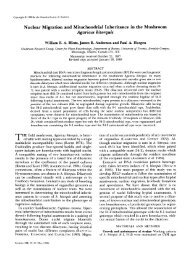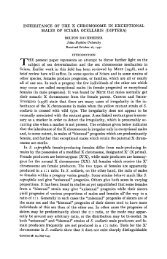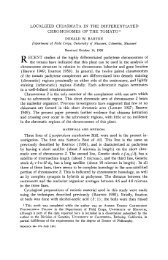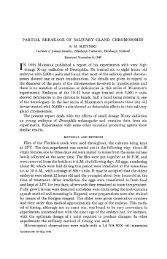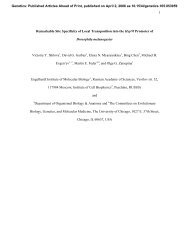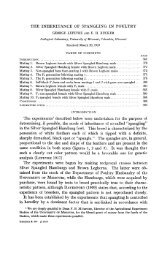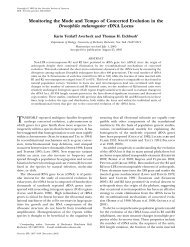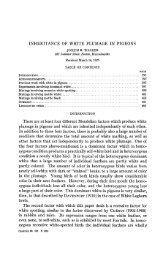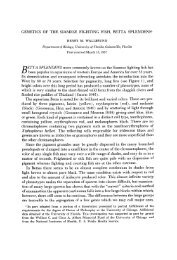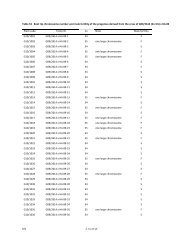abstracts of papers presented at the 1962 meetings - Genetics
abstracts of papers presented at the 1962 meetings - Genetics
abstracts of papers presented at the 1962 meetings - Genetics
You also want an ePaper? Increase the reach of your titles
YUMPU automatically turns print PDFs into web optimized ePapers that Google loves.
ABSTRACTS 977<br />
<strong>the</strong> course <strong>of</strong> <strong>the</strong> experiment were suggested. The trimorphism was prolonged in cage popul<strong>at</strong>ions<br />
begun with 80% ss (homozygous dark) and 20% SS (homozygous light) parents compared with<br />
popul<strong>at</strong>ions begun with equal numbers <strong>of</strong> SS and ss individuals, showing dependence upon <strong>the</strong><br />
frequencies <strong>of</strong> <strong>the</strong>se genotypes in initial popul<strong>at</strong>ions. The shift towards monomorphism was<br />
strongest in cage popul<strong>at</strong>ions begun with Ss parents, hybrids <strong>of</strong> a single homozygous light and a<br />
single homozygous dark strain. The effect <strong>of</strong> strain heterosis on early gener<strong>at</strong>ions <strong>of</strong> certain cage<br />
popul<strong>at</strong>ions was to prolong <strong>the</strong> period <strong>of</strong> trimorphism.-Modifiers both in <strong>the</strong> light and dark direc-<br />
tion caused errors in scoring SS, Ss, and ss phenotypes so as to make necessary individual male<br />
testing <strong>of</strong> samples <strong>of</strong> cage popul<strong>at</strong>ions. These modifiers could be considered homeost<strong>at</strong>ic since<br />
<strong>the</strong>y caused less drastic phenotypic changes compared with genotypic changes in certain popula-<br />
tions. (Supported by Research Grant 6813, from <strong>the</strong> Division <strong>of</strong> General Medical Sciences,<br />
Public Health Service, Be<strong>the</strong>sda 14, Md.)<br />
PRENSKY, WOLF, Biology Department, Brookhaven N<strong>at</strong>ional Labor<strong>at</strong>ory, Upton, New York:<br />
Uptake <strong>of</strong> thymine-methy6Ht by pachytene chromosomes <strong>of</strong> Lilium longiflorum-An<strong>the</strong>rs <strong>of</strong><br />
Lilium longiflorum were tre<strong>at</strong>ed with triti<strong>at</strong>ed compounds (thymidine-H3, thymine-HS, uridine-<br />
H3, adenosine-Hs and leucine-H3) in various stages <strong>of</strong> prophase I. The isotopes were administered<br />
by injection into buds, through cut ends <strong>of</strong> stems, agar blocks placed on cut ends <strong>of</strong> an<strong>the</strong>rs<br />
and agar culture <strong>of</strong> excised an<strong>the</strong>rs. An<strong>the</strong>rs were fixed when <strong>the</strong>y were expected to be in anaphase<br />
11. All methods, except for injection into buds, most frequently resulted in <strong>the</strong> de<strong>at</strong>h <strong>of</strong><br />
<strong>the</strong> an<strong>the</strong>rs Hefore <strong>the</strong> second meiotic division. For injected buds, tre<strong>at</strong>ment with 5 pc <strong>of</strong> thyminemethyl-Ha<br />
(100 pc/ml, S.A. 1.0 C/mM) resulted in positive autoradiographs <strong>of</strong> second division<br />
chromosomes. The isotope was applied during mid-pachytene (bud 19.9 mm long), and grains<br />
were observed over limited areas <strong>of</strong> MI1 and AI1 chromosomes. Since DNA syn<strong>the</strong>sis in pollen<br />
mo<strong>the</strong>r cells has been shown, by autoradiographic as well as enzym<strong>at</strong>ic studies, to occur mainly<br />
in preleptotene, <strong>the</strong> distribution <strong>of</strong> grains in chromosomes labeled during pachytene suggests<br />
<strong>the</strong> occurrence <strong>of</strong> DNA syn<strong>the</strong>sis as a result <strong>of</strong> crossing-over.-Because <strong>of</strong> <strong>the</strong> extensive mortality<br />
<strong>of</strong> tre<strong>at</strong>ed m<strong>at</strong>erial, and <strong>the</strong> uncertainty with respect to successful administr<strong>at</strong>ion <strong>of</strong> triti<strong>at</strong>ed<br />
compounds to surviving pollen mo<strong>the</strong>r cells, neg<strong>at</strong>ive autoradiographs preclude <strong>the</strong> interpret<strong>at</strong>ion<br />
th<strong>at</strong> <strong>the</strong> o<strong>the</strong>r compounds used cannot be incorpor<strong>at</strong>ed. (Research carried out <strong>at</strong><br />
Brookhaven N<strong>at</strong>ional Labor<strong>at</strong>ory under <strong>the</strong> auspices <strong>of</strong> <strong>the</strong> U. S. Atomic Energy Commission.)<br />
RAI, K. S., University <strong>of</strong> Notre Dame, Notre Dame, Ind.: X-ray-induced mitotic changes and<br />
mortality in Aedes aegypti Linn.-Cytogenetic effects <strong>of</strong> X rays (500,l000,2000,4000r) on <strong>the</strong><br />
NIH strain <strong>of</strong> Aedes aegypti Linn. were studied. Larvae were reared under controlled conditions<br />
and were irradi<strong>at</strong>ed six days after h<strong>at</strong>ching <strong>at</strong> a time when most were in <strong>the</strong> early fourth instar.<br />
Five to ten larvae were fixed <strong>at</strong> intervals <strong>of</strong> 0, l%, 6, 12, 18, 36 and 72 hours after irradi<strong>at</strong>ion.<br />
Mitotic chromosomes were studied from squash prepar<strong>at</strong>ions <strong>of</strong> larval brains stained with aceto-<br />
lactic orcein. Mitotic activity was measured in terms <strong>of</strong> <strong>the</strong> total number <strong>of</strong> dividing cells per<br />
brain.-Initially X rays inhibited cell division. Mitotic activity was almost completely sup-<br />
pressed 1% hours after irradi<strong>at</strong>ion. After a time (depending on dose used), this effect was re-<br />
placed by a gre<strong>at</strong> increase in mitotic activity. Twelve hours after irradi<strong>at</strong>ion, <strong>the</strong> larvae ex-<br />
posed to 500 and 1000r showed about twice as many mitotic figures as did <strong>the</strong> unirradi<strong>at</strong>ed ma-<br />
terial. The increase in mitotic activity <strong>at</strong> higher doses was less extreme and took longer to<br />
occur.-Most <strong>of</strong> <strong>the</strong> cell divisions were aberrant. Among <strong>the</strong> chromosomal aberr<strong>at</strong>ions noted<br />
were deletions, exchanges, rings, dicentrics and anaphase bridges. Very few chrom<strong>at</strong>id aberra-<br />
tions were observed.-A rel<strong>at</strong>ionship existed between <strong>the</strong> dose received and <strong>the</strong> developmental<br />
stage <strong>at</strong> which an individual died. The higher <strong>the</strong> dose, <strong>the</strong> earlier <strong>the</strong> de<strong>at</strong>h occurred. Fur<strong>the</strong>r-<br />
more 2000r or more resulted in almost complete mortality.-Adults from larvae receiving 500r<br />
were normal with respect to number <strong>of</strong> eggs laid, percentage <strong>of</strong> egg h<strong>at</strong>ch and subsequent devel-<br />
opment <strong>of</strong> <strong>of</strong>fsprings. (Supported in part by Atomic Energy Commission Research Contract AT<br />
(11-1)-38 and NIH Grant No. E-2753.)





